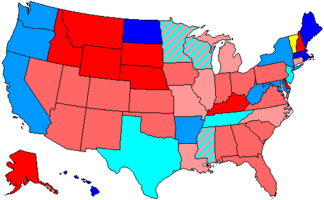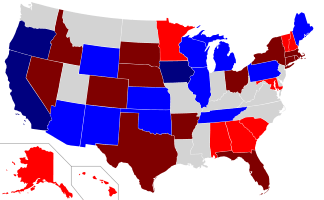United States elections, 2002


The 2002 United States general elections were held on November 5, two years after Republican President George W. Bush won the 2000 Presidential election. Unusual in midterm elections, the incumbent president's party gained seats in both chambers of the United States Congress. The Republicans picked up net gains of 2 Senate seats and 8 House seats.
These elections were held just a little under fourteen months after the September 11, 2001 attacks. Thus the elections were heavily overshadowed by the war on terror, the impending war with Iraq, the Early 2000s recession, and the sudden death of Democratic Minnesota Senator Paul Wellstone about one week before the election.
These elections marked only the third time since the Civil War that the president's party gained seats in a midterm election (the first two being 1934 and 1998), and the first time that this happened under a Republican president. These elections were the second consecutive midterm elections held in a President's first term (regardless of the President's party) where Republicans netted a gain in both houses of Congress.
Federal elections
United States congressional elections
Despite being the incumbent party in the White House, which is usually a disadvantage for the President's party during midterm Congressional elections, Republicans achieved gains in both chambers of the United States Congress.
United States Senate elections
During the 2002 U.S. Senate elections, all thirty-three regularly scheduled Class II Senate seats as well as a special election in Missouri were held.
In the United States Senate elections, the Republican Party achieved an overall net gain of two seats with victories in Georgia, Minnesota, and Missouri while the Democrats took a seat in Arkansas. Thus, the balance of power in the Senate changed from 51-49 Democratic Majority to 51-49 Republican Majority.
United States House of Representatives elections

80.1-100% Republican |
80.1-100% Democratic |
60.1-80% Republican |
60.1-80% Democratic |
50.1-60% Republican |
50.1-60% Democratic |
80.1-100% Independent | |
| House seats by party holding plurality in state | |
During the 2002 House elections, all 435 seats in the House of Representatives plus five of the six non-voting Delegates from non-state districts were up for election that year. These elections were the first to be held following redistricting in apportionment according to the 2000 United States Census.
Republicans succeeded in expanding their majority in the House of Representatives by a net gain of eight, resulting in an 229-204 (excluding Delegates) Republican majority.
In addition to all regularly scheduled House elections, there were two special elections held, one for Oklahoma's 1st congressional district on January 8 and another for Hawaii's 2nd congressional district on November 30.
State elections
Gubernatorial elections

Dark red indicates a Republican hold, light red a Republican pickup, dark blue a Democratic hold, and light blue a Democratic pickup. The results of gubernatorial elections in Guam and the U.S. Virgin Islands (not shown on this map) were a Republican pickup and Democratic hold respectively. All other states in gray did not have gubernatorial elections that year.
During the 2002 gubernatorial elections, the governorships of the thirty-six states, two territories, and the District of Columbia were up for election.
Going into the elections, Republicans held the governorships of twenty-seven states and one territory (that being the Northern Mariana Islands), Democrats held those of twenty-one states, four territories, and the Mayorship of the District of Columbia, and two governorships were held by incumbents of neither party (those being Angus King (I-ME) and Jesse Ventura (MIP-MN)). Following the elections, Republicans sustained a net loss of one state governorship (but did gain the governorship of the territory of Guam), Democrats gained an overall net gain of three state governorships and held on to all other territorial governorships and the Mayorship of the District of Columbia, and there would be no governorships held by Independents or third parties. Thus the balance of power (excluding non-state entities) would be changed from 27-21 Republican majority to 26-24 Republican Majority.
Other state-wide Officer elections
In some states where the positions were elective offices, voters elected candidates for state executive branch offices (Lieutenant Governors (though some were elected on the same ticket as the gubernatorial nominee), Secretary of state, state Treasurer, state Auditor, state Attorney General, state Superintendent of Education, Commissioners of Insurance, Agriculture or, Labor, etc.) and state judicial branch offices (seats on state Supreme Courts and, in some states, state appellate courts).
State legislative elections
In 2002, the seats of the Legislatures of forty-six states and five non-state entities were up for election.
Republicans captured eight legislative chambers from Democrats and also won the majority of state legislative seats for the first time in half a century.[1]
Local elections
Nationwide, there were some cities, counties, school boards, special districts and others that elected members in 2002.
Mayoral elections
During 2002, various major American cities held their mayoral elections that year, including the following:.
- Augusta, Georgia- Incumbent Mayor Bob Young (R), won re-election against former Mayor Ed McIntyre.[2]
- Dover, Delaware- Incumbent mayor James L. Hutchison, Sr (R) was re-elected without opposition.[3]
- Independence, Missouri- Incumbent Mayor Ron Stewart (D) was re-elected.[4]
- Lexington, Kentucky- former Councilwoman Teresa Isaac (D) defeated attorney Scott Crosbie in open seat election to succeed outgoing mayor Pam Miller (D).[5]
- Louisville- Former Louisville Mayor Jerry Abramson (D) was elected mayor of the newly created Consolidated city–county of Louisville-Jefferson County[6] (created as the result of the merger of Louisville city and Jefferson County governments).
- New Orleans- Vice president and regional general manager of Cox Communications Ray Nagin (D) won an open seat election to succeed outgoing Mayor Marc Morial (D).
- Providence, Rhode Island- state Representative David Cicilline (D) won an open seat election to succeed acting Mayor John J. Lombardi. Cicilline thus became the first openly gay mayor of a state capital city and Providence would remain the largest American to have an openly gay mayor[7] until Sam Adams' inauguration as Mayor of Portland, Oregon on January 1, 2009.
- Salem, Oregon- Janet Taylor was elected Mayor of Salem to succeed outgoing Mayor Mike Swaim.[8]
- Washington, D.C.- Incumbent Mayor Anthony A. Williams (D) was re-elected to a second term defeating Councilwoman Carol Schwartz (R).
References
- ↑ Storey, Tim. The Book of the States 2005. The Council of State Governments. Retrieved 2010-01-01 http://www.csg.org/knowledgecenter/docs/BOS2005-LegislativeElections.pdf
- ↑ http://chronicle.augusta.com/stories/112702/met_073-7988.000.shtml
- ↑ http://www.ourcampaigns.com/CandidateDetail.html?CandidateID=176625
- ↑ https://www.ci.independence.mo.us/Downloads/november2002.pdf
- ↑ Fayette County Clerk > Election Results
- ↑ City Mayors: Jerry Abramson - Mayor of Louisville
- ↑ Dahir, Mubarak (December 24, 2002). "Leading Providence: David Cicilline becomes the first openly gay mayor of a U.S. state capital - Politics". The Advocate (Gale Group). Retrieved 2009-05-20.
- ↑ http://www.salemhistory.net/people/salem_mayors_list.htm
External links
- United States Election 2002 Web Archive from the U.S. Library of Congress
| ||||||||||